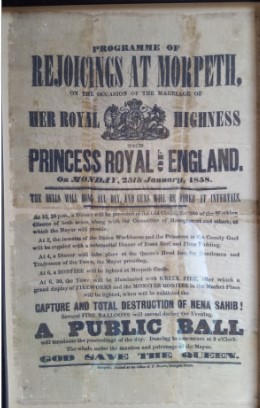As part of the Heritage Open Days 2016 programme – a couple of recently restored Town Treasures were placed back on display in the Council Chamber.
The first is an 18th century oil painting said to be the oldest picture in existence of the main part of the town. The recently updated Town Treasures [1] guide says:
“It had been on exhibition in the Laing Gallery, Newcastle, where it was seen by the late Colonel J.J. Gillespie. He recommended the Town Council of the day to purchase it for its historic and artistic merit. The Curator of the Laing though it might have been painted by Paul Sandby (born 1728) and certainly, as the 1738 part of the Chantry is clearly discernible, this would give weight to this suggestion. It was considered to be a very early and rare example of a landscape done in oils. Though it was expected to realise £250, the Corporation bought it for £60. It was then exhibited in G.B. Grey’s shop in Bridge Street before it was hung in the Town Hall“.

Some interesting little details have emerged from the grime, such as a little red fox on the top of Ha’ Hill and various 18th century Morpethians walking and riding on the road in the foreground!
The second item is a framed silk poster, entitled ‘Programme of Rejoicings at Morpeth’, and listing the events taking place in the town to celebrate the Marriage of Queen Victoria’s eldest daughter, Victoria, the Princess Royal, to Prince Frederick William of Prussia on 25th January 1858.

The marriage was unpopular due to Prussia’s neutrality in the recent Crimean War, but this is not apparent from the planned ‘rejoicings’ which included three separate dinners, one of which was for the inmates of the Union Workhouse and the County Gaol who were regaled with a substantial dinner of roast beef and plum pudding. Indeed, it must have been a noisy day in Morpeth as the bells were rung all day and guns were fired at frequent intervals.
At 6.30pm the town was illuminated with ‘Greek fire’ (a flammable substance which burns on water) after which there was a grand display of fireworks and a ‘monster’ bonfire in the market place.
This was followed by ‘the Capture and total destruction of Nena Sahib!” – presumably a theatrical re-enactment of the defeat in 1857 of Nana Sahib, an Indian aristocrat who rebelled against British rule and captured the city of Cawnpore.
The celebrations ended with a public ball at 9pm. A busy day for the Mayor!
A skilled restorer specialising in textiles had to take great care to remove an old ‘repair’ to the poster, done very inappropriately using sellotape! While some marks can still be seen, the poster has now been stabilised, cleaned and reframed, and looks much better.
Why a poster on silk? We can only guess that since silk lasts much longer than paper and was expensive, the poster was intended to be kept as a royal souvenir.
Footnote:
[1] The “Town Treasures” guide referred to is a revised edition produced in 2014 available from both the Town Council and the Antiquarian Society. The Guide itself probably merits a blog article so watch this space!
